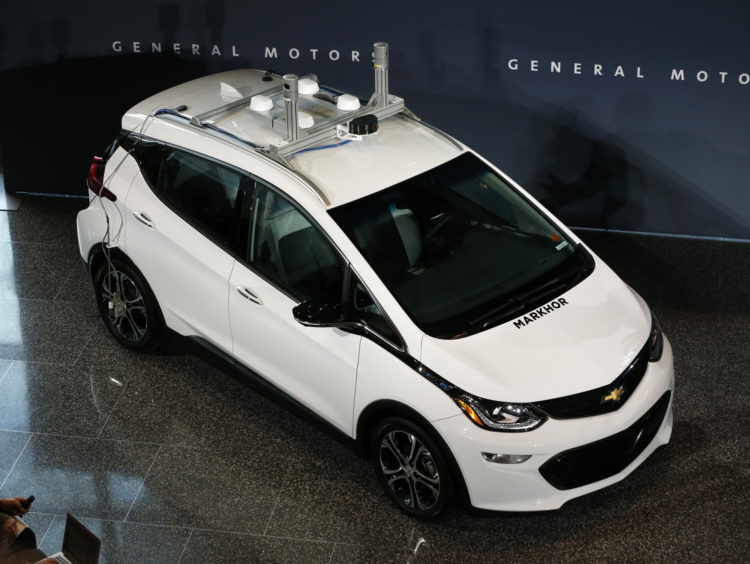GM’s Self-Driving Cars to Be Ready for Ride-Sharing in 2019

published Nov 30, 2017, 3:29:48 PM, by David Welch
(Bloomberg) —
General Motors Co. plans to have its self-driving cars ready for a ride-share service within two years as the automaker looks beyond traditional car ownership for new tech-driven sources of revenue.
After spending more than a year putting the pieces in place to launch a robotaxi business, GM said Thursday it expects to have a fleet of self-driving cars in operation in 2019. The sharing service could be run by the automaker or a partner.
The more than a century-old manufacturer is pushing to be a major player in a future robotaxi business at a time when ride-hailing is growing and auto sales in its home market are slowing. GM is trying to position itself to cash in on a potentially lucrative business that could become a major new source of revenue and generate heftier profit margins, especially since going driverless could dramatically reduce costs.
“It’s a big opportunity,” GM President Dan Ammann said in an interview in San Francisco this week. “We think it will change the world.”
Ride-hailing services on the roads now, including those offered by Uber Technologies Inc. and Lyft Inc., cost consumers about $2 to $3 a mile, with the companies paying their drivers the equivalent of about three quarters of revenue, GM estimates. Take away driver costs and the rates could drop to below $1 a mile, said Kyle Vogt, chief executive officer of Cruise Automation, the San Francisco-based unit that develops the software for GM’s self-driving cars.
The challenge for GM will be getting its share of the revenue, said David Whiston, an analyst with Morningstar Inc., said by phone. Picking a partner likely would mean having to split earnings. If the automaker runs its own business, it’ll have to deal directly with consumers and beat out competitors who will have been in the market for years.
“It will be a crowded space,” Whiston said. “Uber has a lot of issues, but they still have a nice first-mover advantage.”
Ammann told analysts and investors Thursday that GM’s plan to get self-driving cars to market in large numbers could drop the costs of ride-sharing under $1 a mile by 2025. Once that happens, he said, 75 percent of the miles people drive could be through sharing or hailing services. That’s a $1.6 trillion market, which is 300 times larger than today, he said.
To get there, GM is lowering the costs of self-driving cars both by building out its manufacturing capabilities and supply base and finding better technology. Lidar systems that use laser technology to give vehicles a view of the road now cost about $20,000, Vogt said. GM is switching to lidar units developed by Strobe, a company the automaker acquired this year, which will cost $300 apiece, he said.
The outlook for when GM thinks it’ll have a self-driving service ready roughly coincides with when Uber will begin taking delivery of 24,000 sport utility vehicles from Volvo Cars expected to be capable of piloting themselves. Waymo, the autonomous car unit of Google parent Alphabet Inc., earlier this month said it’s about to start chauffeuring people in Fiat Chrysler Automobiles NV-supplied minivans without safety drivers manning the steering wheel.
“If they can roll this out on that time horizon, they’re further along than they’ve been given credit for,” Jeff Schuster, an analyst at researcher LMC Automotive, said by phone of GM’s plans for 2019. “The reason we’re seeing such a race to this is not because the money is there right now — it’s all about image. It’s being there first and setting the standard.”
Earlier this week, GM showed off its self-driving Bolt to analysts and media to display its capabilities on the busy public streets of San Francisco. Ammann told investors that GM could bring in revenue of several-hundred thousand dollars over the lifetime of each autonomous car in a ride-share business, compared with about $30,000 per vehicle sold now.
GM also sees big revenue opportunities in the data generated by self-driving vehicles. The cars will capture information about traffic, consumer habits, how delivery services work and what happens in car accidents, Ammann said. That could help GM create a massive Internet of Things platform that could be of use to a variety of businesses, including insurance and delivery companies.
“We will have a level of data that will be unprecedented,” Ammann said.
The battery-powered Chevrolet Bolt has been GM’s vehicle of choice for self-driving cars because they’ll need minimal maintenance and upkeep even when in constant use as part of a ride-share fleet, Vogt said.
The automaker’s aggressive push into self-driving cars, electric drive and ride-sharing has been a key reason why the stock has soared in recent months. GM’s stock has climbed 24 percent this year, compared with crosstown rival Ford Motor Co.’s 3.2 percent gain. GM shares slipped 1.6 percent to $43.09 on Thursday.
–With assistance from Keith Naughton.To contact the reporter on this story: David Welch in Southfield at dwelch12@bloomberg.net To contact the editors responsible for this story: Craig Trudell at ctrudell1@bloomberg.net Anne Riley Moffat
COPYRIGHT © 2017 Bloomberg L.P



No Comment